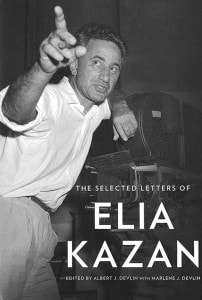
On Aug. 15, 1952, Elia Kazan was on a film shoot, facing one of his worst fears: a day off. “My source of dope (work),” he wrote to his wife, had been “taken away.”
No wonder he felt withdrawal. In the preceding five years, Kazan, just 43, had directed the Broadway premieres of A Streetcar Named Desire, All My Sons and Death of a Salesman, won an Oscar for Gentleman’s Agreement, and made six other films, including Streetcar. (In his spare time he had also co-founded the Actors Studio.) While that output alone secures Kazan’s place in the pantheon, it only marked the peak of a four-decade career that began with a backstage apprenticeship to the Group Theatre in 1932, where he earned the nickname “Gadget” or “Gadg,” and lasted through the late 1960s, when he retired from directing after 25 Broadway plays and 17 major motion pictures. (He lived on another 30-odd years in relative seclusion writing novels before dying in 2003 at the age of 94.)
What comes through from The Selected Letters of Elia Kazan, edited by Albert J. Devlin with Marlene J. Devlin, is the role sheer workaholism played in his extraordinary career. While his life and work were well documented in a recent biography by Richard Schickel, and in Kazan’s own 1988 memoir, A Life, nothing beats the raw material of the letters in conveying the moment-to-moment thrills as he shuttles back and forth between projects, the likes of which most directors can only dream of.
While no one matched Kazan for ambition and ego, his correspondence with actors, designers and, above all, playwrights reveals that his genius was for collaboration. It’s no coincidence that almost all of Kazan’s theatre projects were new American plays. While he’s been criticized for his heavy hand with writers, these letters show what an expert dramaturg Kazan was; he offers both praise and criticism, but always with an eye to realizing the playwright’s essential vision onstage.
In tryouts for Thornton Wilder’s notoriously complex The Skin of Our Teeth the 33-year-old director implores the veteran writer to revisit his third act, during which audiences are drifting, because “a scene which must necessarily be quiet and subdued seems too low for so late in the evening.” To Archibald MacLeish, whose biblical fantasy J.B. was another departure from Kazan’s signature naturalism, he insists, “There is something basically under-dramatic to me about staging which alternates between action and comment on action.”
None of his collaborations were longer or more tempestuous than the magical symbiosis he achieved with Tennessee Williams. As partners through four plays and two films, the ultra-practical disciplinarian director and notoriously erratic dramatist carry on a love-hate affair in this book as intense as any in the latter’s scripts. After public accusations that he had interfered too much with Williams’s writing, he fires back, “You were willing to have me blamed for the faults in your plays, while you are praised for their virtues….Well, Tennessee, fuck that!” Yet even long after their last project together in 1959 (Sweet Bird of Youth), we find the playwright still sending “Gadg” rough drafts of new work well into the 1970s.
Other compelling narratives traced in the letters include Kazan’s battles against the censorship of his films; his attempts to resist commercial pressures by forming independent production companies; and his growing attraction to films and novels as media in which he could better tell his own stories (like his 1963 immigrant epic America, America). Perhaps most eye-opening is the extensive correspondence on his role in founding the Repertory Theater of Lincoln Center in the early 1960s. Often dismissed as a half-hearted, short-lived failure, the enterprise strongly attracted Kazan, whose letters about it constitute something of a culminating manifesto. Rather than a European-style classical repertory troupe, he envisioned a company devoted almost exclusively to the work of living American playwrights. But he and Lincoln Center parted ways after only one season.
Many of the volume’s shortcomings stem from its inevitable one-sidedness: We get only Kazan’s letters, not his respondents’. This especially skews the more controversial aspects of his life. We only hear his defense of his cooperative 1952 HUAC testimony, which alienated many of his colleagues. Likewise, his other infamous betrayal—that of his wife, Molly Day Thacher, herself a seasoned “script reader” deeply involved in his work—is depicted only through his brazen defenses of his (many) infidelities, not her replies.
Ultimately, though, this collection transcends Kazan’s flaws by foregrounding the persistent relevance of his work. Love him or hate him, it is hard not to come away from these letters inspired by his constant striving to “vitalize on stage the experience of our times.”
Garrett Eisler writes frequently for this magazine.

